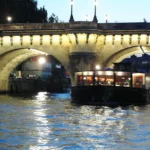Wandering the luminous streets of Paris, few sights captivate as the Eiffel Tower, standing tall and proud by the Seine. This emblematic iron lattice marvel, rooted deeply in French culture and architectural history, offers more than just a panoramic view of the City of Lights. Whether arriving from bustling Gare du Nord, the chic Charles de Gaulle Airport, or navigating the local metro, your journey to this tower promises discovery and delight.
Table of Contents
Tracing the Iron Lady’s Story and Symbolism
Constructed for the 1889 Exposition Universelle, the Eiffel Tower was initially met with skepticism and even disdain by some Parisian artists and intellectuals. Yet, it swiftly transformed into a beloved symbol of technological prowess and modern art nouveau design. Gustave Eiffel’s masterpiece, originally intended as a temporary installation, now stands as Paris’s most visited paid monument, representing the daring spirit and elegance that frame the city’s identity.
One may not know that this metallic structure’s intricate latticework was designed to withstand heavy winds, a marriage of aesthetics and engineering that was groundbreaking at its birth. Visitors sharing a moment on its platforms also participate in a tradition painted with history and cultural pride.
Getting There and Navigating Urban Pulse
The Eiffel Tower nestles in the 7th arrondissement along the Seine’s left bank. From Paris’s core, the simplest route is by metro. Take line 6 to Bir-Hakeim station or line 9 to Trocadéro for perhaps the most breathtaking initial views across the water. Bus routes, notably 82 and 87, and river ferries along the Seine offer scenic alternatives.
After visiting the Eiffel Tower, a gentle stroll around Paris’s calm streets reveals charming local spots detailed in this Paris stroll guide.
From Charles de Gaulle Airport, the RER B train towards Paris city center and a change to the metro line 6 or 9 will lead you comfortably to the tower’s vicinity. For those arriving by train to Gare de Lyon or Gare Montparnasse, the metro’s extensive reach provides seamless access.
Nearby Lodging and Local Flavor to Savor
Surrounding the tower, the Saint-Germain-des-Prés and Champs de Mars neighborhoods invite visitors to linger. Ideal accommodation ranges from charming boutique guesthouses to welcoming apartments. As afternoon unfolds, take time to sip an espresso in a nearby literary café or indulge in artisanal pastries at a street bakery, truly savoring Parisian gastronomic heritage.
Visitor Insights: Best Time and Referral Tips
Planning a visit during weekdays in spring or autumn offers a quieter, more contemplative experience. Early morning fog often adds a touch of mystique to the views, while late evenings illuminate Paris in a canvas of twinkling lights below the tower’s own sparkling beacon.
After admiring the Eiffel Tower, you might appreciate a visit to the Arc de Triomphe, where Paris’s grand avenues and history come alive.
- Book tickets online in advance to avoid long queues, especially during weekends and holidays.
- Ascend early or late in the day when light pours soft and shadows play, ideal for photography enthusiasts.
- Consider dining at the tower’s exquisite restaurants for a culinary experience woven into architectural splendor.
Reservation Requirements and Tour Options
Official access requires a ticket, purchasable on-site or ideally through the tower’s carefully curated website, ensuring authentic and secure booking. Multiple options exist – from stairs climbing for the adventurous to elevator rides offering breathtaking aerial snapshots. Guided architectural tours unveil deeper narratives about its construction and place within Parisian society.
After enjoying the Eiffel Tower, many find a peaceful cultural contrast in the Louvre Museum’s timeless art collections, just a short metro ride away.
Hidden Stories and Unique Experiences at the Tower
Beyond the well-trodden paths, explore the tower’s lesser-known corners. The glass floor on the first level challenges your perspective and invites thoughtful pauses. At night, the light show dances across the iron mesh, enchanting all with its ephemeral poetry.
Local lore tells of secret apartments Gustave Eiffel crafted at the summit for ornate gatherings and scientific experiments – some of this history woven into visiting exhibitions. Spotting ice-cream vendors or lively street musicians nearby adds a jovial heartbeat to the tower’s stately persona.
Community Spaces and Cultural Engagement Nearby
Field-side parks and riverside walks encourage enjoyment of informal picnics or participation in spontaneous social gatherings. The Esplanade below serves as a cultural hub with seasonal festivities, open-air cinema, and artisanal market stalls. Engage with locals sharing stories over freshly baked baguettes or handcrafted chocolates, absorbing the layered urban heritage.
How the Eiffel Tower Shapes Parisian Urban Heritage
As you meander through adjacent neighborhoods, notice how the tower frames the skyline from numerous angles, asserting its presence in Paris’s evolving fabric. From architectural tours highlighting its interplay with Haussmannian boulevards to festivals celebrating French artisan traditions, the tower catalyzes a rich cultural dialogue unique to this urban stage.
Web Resource for Authentic Visiting Experience
For comprehensive planning, ticket reservations, and updates on exhibitions or events, consult the Official Eiffel Tower Website. This site offers clear information in multiple languages and exclusive insights into visiting options, ensuring a seamless, memorable encounter with Paris’s iron lady.

Lover of cities, local cafés, and historic streets, exploring urban life with attention to architecture and culinary delights.
- Eiffel Tower Paris June 2010 by King of Hearts on Wikimedia Commons – cc by-sa 4.0
